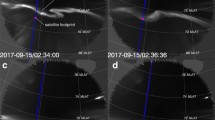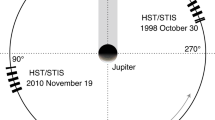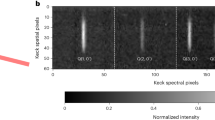Abstract
PREVIOUS investigations have shown that the hydrogen lines are usually absent from spectrograms of the auroral luminescence. Even when the stronger lines and bands are much over-exposed and also very faint lines appear, there may still be no trace of the H-lines visible on the spectrogram1,2,3,4. This does not mean, however, that hydrogen may not occasionally appear in three regions. On the contrary, some years age I gave, for the luminous night clouds, an explanation3 based on the assumption that showers of hydrogen, coming from the sun, entered into the atmosphere and combined with oxygen, for example, in the atomic or ozone state, to form water vapour. At the altitude of the luminous night clouds (80 km.), the atmospheric pressure might be sufficiently great for the water vapour to condense and produce clouds of ice needles.
This is a preview of subscription content, access via your institution
Access options
Subscribe to this journal
Receive 51 print issues and online access
$199.00 per year
only $3.90 per issue
Buy this article
- Purchase on Springer Link
- Instant access to full article PDF
Prices may be subject to local taxes which are calculated during checkout
Similar content being viewed by others
References
Vegard, L., Phil. Mag., 46, 195 (1923); J. Phys., 16, 367 (1923).
Vegard, L., Geof. Publ., 9, No. 11 (1932).
Vegard, L., Geof. Publ, 10, No. 4 (1933).
Vegard, L., and Harang, L., Geof. Publ., 11, No. 15 (1936).
Author information
Authors and Affiliations
Rights and permissions
About this article
Cite this article
VEGABD, L. Hydrogen Showers in the Auroral Region. Nature 144, 1089–1090 (1939). https://doi.org/10.1038/1441089b0
Issue Date:
DOI: https://doi.org/10.1038/1441089b0
This article is cited by
-
North–South Asymmetries in Earth’s Magnetic Field
Space Science Reviews (2017)
Comments
By submitting a comment you agree to abide by our Terms and Community Guidelines. If you find something abusive or that does not comply with our terms or guidelines please flag it as inappropriate.



